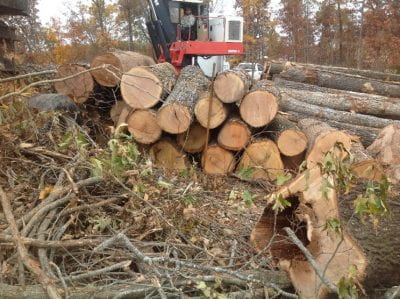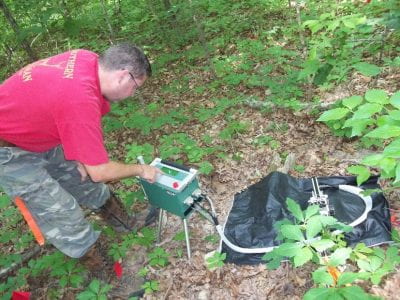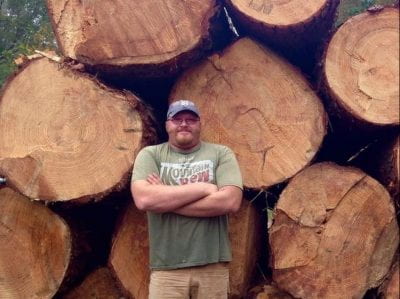Managing our Forestlands
University of Arkansas System Division of Agriculture Forest Management Plan
Executive Summary
The University of Arkansas System Division of Agriculture’s research unit, the Arkansas Agricultural Experiment Station, or AES, comprised of five research and extension centers and seven research stations, operates research forests at four of its locations across the state:
- The Livestock and Forestry Research Station near Batesville, with approximately 2,000 forested acres
- The Pine Tree Research Station near Colt, with approximately 8,000 forested acres
- The Savoy Research Complex, near Fayetteville, with approximately 2,200 forested acres
- The Southwest Research and Extension Center near Hope, with approximately 260 forested acres
The forest resources on these centers and stations were originally managed by a resident director with input from administration and a registered forester. All these centers and stations had active forest management research and demonstration projects directed by faculty from AES and the College of Forestry, Agriculture and Natural Resources at UA-Monticello. However, timberland acreage on some areas was under-managed for forest health and productivity, largely due to a decline in research grant opportunities, a shortage of forest management personnel, and timber market constraints. The notable exception is the Livestock and Forestry Research Station, where the resident forester, AES forest research faculty, and the resident director have successfully managed the forest for many years.
In May 2020, Arkansas Agricultural Experiment Station administration championed a more active role in managing the forest resources and hired a forester tasked with creating, updating and implementing forest management plans for all Division of Agriculture-owned forests. This report briefly summarizes the history, past management, current management actions, and future plans for AES forestlands.
Guiding Management Goals for AES Forestlands
AES forestlands located across the state represent forest types and management considerations unique to their specific regions. The overall goal of the Division of Agriculture’s forest management plan is to produce healthy, vigorous forests that are representative of the forest resources in their specific area of the state. The plan is intended to provide wood, wildlife habitat, clean water, carbon sequestration, and other benefits. A final objective is to create forest management resources and programs to assist local forest landowners and managers in meeting personal management goals on their forestlands.
Personnel
To accomplish the goals for forest management on AES forestlands, the following units and personnel will be involved:
- AES Administration: Role is to provide active oversight and assistance for forest management of AES forestlands.
- Jean-François Meullenet, Senior Associate Vice President for Agriculture-Research and Director of the AES: jfmeull@uada.edu
- Nathan Slaton, Associate Vice President for Agriculture and Assistant Director of the AES: nslaton@uada.edu
- AES Research Station Directors: Role is to provide active oversight and assistance for projects at a specific AES location.
- Don Hubbell, Resident Director, Livestock and Forestry Research Station: dhubbell@uada.edu
- Shawn Clark, Resident Director, Pine Tree Research Station: sdc01@uada.edu
- Daniel Rivera, Resident Director, Southwest Research and Extension Center: drivera@uada.edu
- Nathan Slaton, Associate Vice President for Agriculture and Assistant Director of the AES: nslaton@uada.edu
- AES Statewide Forester: Role is to create, update and implement forest management plans and oversee all forest management operations on AES forestlands.
- Mike McGowan, AES Forester: mmcgowan@uark.edu
- Arkansas Forest Resources Center (AFRC) Research Faculty: These include researchers located at UA-Monticello’s College of Forestry, Agriculture and Natural Resources, and the Arkansas Agricultural Experiment Station, whose responsibility is to generate research and manage demonstration forests to provide forest education program opportunities.
- Michael Blazier, Director, Arkansas Forest Resources Center: Blazier@uamont.edu
- Cooperative Extension Service (CES) Forestry: Role is to conduct research and outreach to the public about forest management issues, forest health, timber pricing, wood product marketing, and supplying forestry support tools.
- Kyle Cunningham, Associate Professor of Forestry: kcunningham@uada.edu
Partners
During the development of this plan, input for management operations to achieve desired management goals was sought from our partners including the Arkansas Department of Agriculture – Forestry Division, Arkansas Game and Fish Commission (AGFC), and the U.S. Forest Service. We greatly appreciate the time spent to provide input to help us achieve our goals. Partners were invited to review all four stations but were asked to provide specific input for the Pine Tree Research Station. Where appropriate, recommendations from partner agencies have been incorporated. Partner comments can be viewed on page 46.
Best Management Practices
All harvest operations on AES forests employ Best Management Practices (BMPs) for water quality. BMPs are a set of guidelines for timber designed to protect water quality and reduce erosion during harvest by limiting the impact of a harvest on the site and nearby waterways. BMPs may include where to employ streamside management zones (SMZs) or areas with limitations on harvesting near streams, how to establish and/or close logging roads and skid trails, and other guidelines. The complete list of BMPs can be found at the Arkansas Department of Agriculture – Forestry Division website.
Disclaimer
Some historical records have been lost or are unreadable or refer to landmarks that no longer exist for navigation and project locations. The exception is at the Pine Tree Research Station, where a management plan was regularly updated and audited by the U.S. Forest Service from 1960 until 1976, when oversight by the Forest Service was discontinued. This document attempts to estimate current resources and doesn’t claim to be authoritative regarding the management dating back several decades.
Glossary
of key forestry terms used in this management plan
- Agroforestry/Silvopasture: A form of land management that uses a low density of trees combined with forage for livestock. The practice allows landowners to manage for cattle and some timber simultaneously.
- Basal Area (BA): The metric which provides standardized comparison among forest stands. It is simply the cross-sectional area of a tree at 4.5 feet above ground. If one were to measure the BA of all trees on an acre at 4.5 ft above the ground, the cumulative areas would occupy some percentage of the total 2D area of the acre. Thus, the area of wooded stems would represent the basal area of the acre (BA/ac) in square feet. For example, “The pine plantation had a basal area of 120 square feet BA/ac.”
- Bottomland Hardwoods: Forest stands occurring in an active floodplain of a river or stream that contain hardwood species (e.g., oak, gum or hickory species).
- Bottomland Terrace Hardwoods: Forest stands occurring on sites that were once active floodplains, but that no longer flood. These occur at a slightly higher elevation than the active floodplain and may contain some upland hardwood species (e.g., white oak, post oak, and mockernut hickory).
- Chemical: In forestry, the term chemical refers to herbicides used to control unwanted vegetation.
- Controlled Burn/Prescribed Fire: A planned fire for a specific set of conditions and specific area of land. See the video: Prescribed Fire and Vegetation Control
- Burn Blocks: Specific units of land designated for a prescribed burn.
- Control Block: An area of forest where no treatments are applied to establish a base for comparisons among other treatments.
- Diameter at Breast Height (DBH): Tree diameter measured at 4.5 feet off the ground on the uphill side of the tree. This is the measurement that determines a tree’s size class.
- Even-Age Forest Stand: A stand of trees where most of the trees are the same age or close to the same age.
- Fire Break: A lane created by mechanical removal of vegetation, designed to prevent fire from crossing into adjacent land areas.
- Fuel: Vegetation that will be used to carry a fire across an area. Fuel can be leaf litter, woody debris, shrubs, grasses, and vines.
- Hack and Squirt: Using a hatchet and a plastic squirt bottle containing herbicide, notches are made in the tree and chemical is sprayed into the notch to be absorbed by the tree.
- Injection Work: (See Hack and Squirt)
- Midstory: The component of trees in a forest stand that are located between the forest regeneration at ground level (understory) up to the main canopy trees (overstory). Often these stems are 1-5 inches in DBH.
- Regeneration Harvest: A harvest operation designed to reestablish a new forest with tree seedlings and sprouts. These harvests can include natural regeneration and/or include tree planting.
- Shelterwood Harvest: A two-stage regeneration harvest where the tract is thinned to a target BA/acre, typically near 50 BA/acre in southern hardwood forests, to allow light to the forest floor, increasing germination of new seedlings, and increasing the growth rate of existing seedlings and saplings. Once sufficient numbers of crop tree species seedlings are present on the forest floor, the remaining shelter trees may be removed (e.g., the remaining trees are harvested), and the young trees allowed to develop, usually 3-5 years after the initial shelterwood thinning. Alternative method could include leaving shelter trees to create a two-age stand for more diversity. See the video: Example of a Recent Shelterwood Harvest
- Clearcut Harvest: A technique for removal of all merchantable stems in a specific area.
- Stand or Forest Stand: A specific unit of a forest with trees similar in species, size, and number. See the video: Basic Stand Evaluation Measurement
- Thinning: The removal of pre-selected, individual trees down to a preset basal area limit. Usually done to provide more resources to remaining trees, and to improve forest health.
- Thin from Above: A method of thinning where trees to be removed are selected from larger to smaller crown sizes.
- Thin from Below: A method of thinning where trees to be removed are selected from smaller to larger crown sizes.
- Q-Factor: A method of thinning based on the number of trees in all size classes, where a desired number of trees per size class is established with any extra trees being harvested, creating a constant supply of growing sawlogs. Not often seen in shade intolerant southern forest types, it is more common tool for managing uneven-aged forests with shade tolerant species.
- See an example in these videos: White Oak Sustainability and White Oak Sustainability, Part 2.
- Timber Cruise: A method of systematically measuring a stand of trees to determine species present, tree size, tree quality, and other measures. These data are useful in determining basal area, volume, health, composition and value of a specific forest stand.
- Two-Age Forest Stand: A stand of trees with two distinct age groups of trees present.
- Un-Even Age Forest Stand: A stand of trees where three or more age groups occur in the same unit.
- Variable Retention Harvest for Wildlife: A thinning method that removes various tree sizes at varying post-harvest densities to retain a variation of structure within a stand.
- Woodland: Refers to a stand of trees that is more open (fewer trees) than typical forest.
References
Cunningham, K.K., Peairs, S.E., Ezell, A.W., Belli, K.L. and Hodges, J.D., 2011. Understory light conditions associated with partial overstory removal and midstory/understory control applications in a bottomland hardwood forest. Forests, 2(4), pp.984-992.
Miller, G.W., Brose, P.H. and Gottschalk, K.W., 2017. Advanced oak seedling development as influenced by shelterwood treatments, competition control, deer fencing, and prescribed fire. Journal of Forestry, 115(3), pp.179-189.
Self, A.B., Willis, J.L. and Ezell, A.W., 2020. Oak regeneration success in operational shelterwood cuts: year two results. e–Gen. Tech. Rep. SRS–253. Asheville, NC: US Department of Agriculture, Forest Service, Southern Research Station, 253, pp.230-234.

Savoy Research Complex

Livestock and Forestry Research Station

Pine Tree Research Station

Southwest Research and Extension Center
